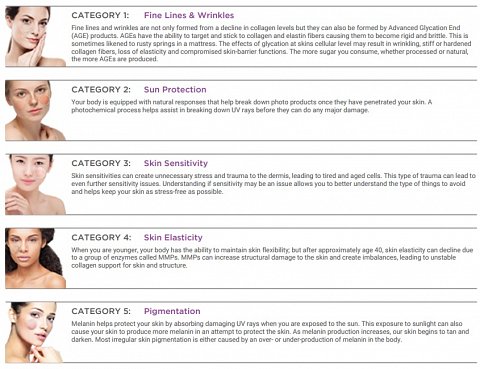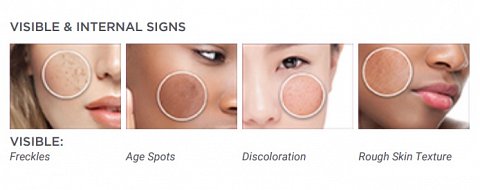-
Skin Care
review on January 15, 2018
by Ellen Hinkley

At a Glance
Summary
The Skin Care DNA test from HomeDNA provided some interesting insights into my skin health and advice about the potential issues that I should look out for. The way in which results were displayed on a scale made them clear and easy to interpret. I also found the recommendations useful, and appreciated that so many were provided.
This said, due to the quantity, it was a little difficult to know which ones to prioritize, and there was also a lot of text to read through to fully understand the areas that had been examined. I’d recommend this test if you’re looking for a detailed guide and already have an idea of the area of skincare you’re looking to improve, but maybe not if you’re interested in more general insights and quick fixes.
Full Review
HomeDNA is a relatively new brand, established by one of the oldest DNA testing providers, DNA Diagnostics Center (DDC). Founded back in 1995 by Dr Richard Lee, DDC now processes more than a million samples a year from its lab in Fairfield, Ohio. The company is currently run by Connie Hallquist, and operates in 168 countries around the world.
Whilst DDC specializes in a wide range of DNA test types, HomeDNA focuses on Ancestry, Health, and Skincare specifically, empowering customers to gain insights and improve their lifestyle, using information about their DNA. I was interested to see what their Skin Care DNA test would have to offer.
Product Expectations
The HomeDNA website provided plenty of information about the Skin Care DNA test. It sorted into six tabs, which made it easy to find the specific details I wanted. I read that the test would identify my skin’s potential and provide personalized recommendations, by looking at seven key areas. These included ‘Collagen Quality’, ‘Skin Elasticity’, ‘Fine Lines & Wrinkles’, ‘Sun Protection’, ‘Pigmentation’, ‘Skin Antioxidants’ and ‘Skin Sensitivity’.
The benefits of the test were described, as well as what I’d receive in my results, the science backing them, FAQs, a ‘How it works’ section, and information about the HomeDNA brand.
Pictures of the kit and its contents accompanied the description, which I appreciated, as it showed that the sample would be taken via a swab, and I could see that return postage would be included.
Ordering Experience
The ordering process was straightforward. I added the kit to my cart and headed straight to the checkout. Then, I entered my address and was pleased to see that standard shipping was free, especially considering I’d already seen that return postage was prepaid.
I was able to pay with Mastercard, Visa, Discover, American Express or PayPal, but before submitting my payment information, I checked through the T&Cs and Privacy Policy. I was impressed to read that HomeDNA would only use my genetic data to provide me with the service I’d requested, to process the order and to respond to any billing issues. They were written quite clearly and didn’t include anything that concerned me.
Once I’d looked through these policies, I submitted my payment information and received an email to confirm the order.
I received my kit within the time estimated, though was a bit disappointed to find that, rather than the box shown on the website, the kit was an envelope. This was fine in my case, but I think it may have been a little underwhelming if I’d bought or received it as a gift. The swabs were simple to use, though I found that some of the moisture seeped through the sample envelope. I was worried I’d skipped an instruction that told me to let them dry first, but when I double checked there wasn’t one.
When registering my samples, I was asked to enter my gender, age, date of birth and ethnicity (though was assured that this wouldn’t be reported with my results). The process required me to set up a HomeDNA account, which I would later use to access my results.
I put the samples into the envelope with the prepaid postage and popped it in the post. I received an email three business days later, informing me that HomeDNA had received my samples at their lab.
The Results
Two weeks later, I received an email to inform me that my results were ready, with a link to log in and view them. Logging into my account, I was taken to a page where I could view or download my report as a PDF.
The front page was personalized with my name, reference number and date on which the report had been completed. I scrolled down to an introductory page called ‘How to read your results’, which included three main sections: ‘Understanding Your Genetic Score’, ‘Your Gene Profile Overview’ and ‘Recommendation Guidelines’.
Reading through them, I realized that each title corresponded to a feature of the results, explaining how each worked and what it would tell me about that result. This was a useful introduction and was also helpful to refer back to when going through the report.
The next section was a contents page, listing the seven areas of skin health I’d seen in the product description on the website. Each was accompanied by a picture and a short introductory paragraph (shown below).

The contents page.
Results Section: Your Genetic Score
I decided to start by looking at the results that seemed to be related to aging. The first full result in the report was Fine Lines & Wrinkles. The introductory paragraph I’d read on the contents page had explained that things called Advanced Glycation End products (AGEs) could cause fine lines and wrinkles, and were increased by the consumption of sugar. The result section expanded on this, explaining that these AGEs were created as a result of the body trying to break down sugar. I knew that sugar was bad for health in general, but had never realized that it had an effect on skin health specifically.
The other results had similarly interesting and helpful descriptions, which in general, were explained at the right level of complexity. There were a few phrases such as ‘enzymes’ that I wasn’t sure about the meaning of, and couldn’t find any explanation for, but a simple Google search revealed that these were basically ‘biological catalysts’, which made sense.
The results themselves were displayed on a scale, showing a spectrum of colors, from red to blue. The red end of the scale was labelled ‘Non-Ideal’ and the blue was labelled ‘Optimal’. On the scale itself, there were two markers, one labelled ‘Global Average’ and one labelled ‘You’ (shown below).

My Fine Lines & Wrinkles overall result.
These labels were all pretty self-explanatory, but I could have read descriptions of exactly what each one meant on the introductory page, had I wanted further explanation.
I was happy to see that my marker was nearer to the Optimal end of the scale than the Global Average for my Fine Lines & Wrinkles result. The explanation of the result was pretty basic, stating that it meant I “carry few of the gene variations associated with glucose-related fine lines and wrinkles”. The same format was followed by most of the results, with ‘few’ replaced with words like ‘some’. However, I appreciated how clear the result was, and thought that the inclusion of the Global Average marker added more value to the results, as it provided context.
Results Section
Additional information about the result was provided in the ‘Your Gene Profile’ section, which contained separate results (‘Non-Ideal’, ‘Standard’ and ‘Optimal’) and explanations for each gene that had been analyzed to determine the overall result. The number of genes analyzed for each result varied; Skin Sensitivity and Skin Antioxidants included five each, but Pigmentation only had two. The Your Gene Profile section for Pigmentation is shown below.

My Gene Profile for my Pigmentation result.
I was a little confused by this result, as both of my genes were Optimal, meaning that my overall ‘You’ marker was right at the Optimal end of the scale, and significantly higher than the ‘Global Average’ marker. I am very fair skinned and burn easily, and therefore, at first glance, was pretty sure this result was inaccurate. However, looking more closely, I realized that the result was about irregular pigmentation, and due to my low level of pigment, I had a lower chance of irregularities.
Whilst this made sense, I was still a bit baffled about the results Gene Profile. Although it was apparently Optimal, the Tanning Response explanation seemed to describe all the ways in which this made my skin more sensitive to burning and less likely to tan. My Freckle Factor also came back as Optimal, but the description referred to me having a standard risk.
Other results were more straightforward, however. I found out that my skin sensitivity was likely to be slightly less optimal than the global average, as all my gene results were Standard, other than fragrance, which was Optimal. This really reflects what I have experienced, as my skin doesn’t tend to be particularly sensitive, though there are occasions where I’ll react to something. I was again a little confused by this result at first, as I noticed that the first three genes were all labelled ‘Skin Sensitivity’ and the last two were ‘Pollution/Fragrance’. However, looking more closely, I realized that they corresponded to genes with different numbers, though I wasn’t sure what these stood for and couldn’t find any explanation.
Results Section: Visible & Internal Signs
There was also a section called ‘Visible & Internal Signs’, which described and showed images of the characteristics associated with each result. The images were pictures of faces with the feature magnified. An example is shown below.

The visible signs of pigmentation.
These were useful for some of the results, especially with features like ‘Jowls’ which I hadn’t heard of before, but for others it was a little difficult to see exactly what was being magnified, and the quality wasn’t good enough to zoom in very far.
The ‘Internal Signs’ weren’t always what I would consider internal issues. For example, ‘Premature Wrinkles’ was mentioned in one result, and ‘Skin Dehydration’ in another. For a couple, there were only visible and no internal signs. I wasn’t sure why this was, but overall this added a bit of imagery to the results and gave me more of an idea of exactly what aspects of my skin health they were looking at.
Results Section: Your Recommendations
A ‘Your Recommendations’ section provided skincare advice, which was split into ‘Topical Ingredients’, ‘Supplement Ingredients’ and ‘Professional Treatments’. For results where my marker was closer to the Optimal end of the scale than the Global Average one, this section only included one overall recommendation: to consider using vitamin C or E antioxidants to maintain my skin health, as my overall risk was low.
However, for others, there were several separate pieces of advice included in these columns. My Skin Elasticity result was the furthest below the Global Average, so I was particularly interested in these recommendations (shown below).

The recommendations for my Skin Sensitivity result.
Under the Topical Ingredients section, there were six ingredients listed, each accompanied by a short description of its benefits. Although I didn’t recognize all of them, I thought it was really useful to have a list of ingredients to look for in skincare products.
I was surprised by the Supplement Ingredients column, as I’d expected them all to be vitamins. I’d never heard of things like Alpha Lipoic Acid, and didn’t think I’d be able to find it in any shops. However, a quick search of The Vitamin Shoppe’s website (the only shop I could think of to buy supplements), showed they were available to buy. Whilst I probably wouldn’t take all the supplements, it was good to have a few different options.
The final column of the table provided professional treatment recommendations, which was equally useful, especially as these tend to be quite expensive – it was great to be able to choose one without worrying I was wasting my money on something I might not need.
Summary
The Skin Care DNA test from HomeDNA provided some interesting insights into my skin health and advice about the potential issues that I should look out for. The way in which results were displayed on a scale made them clear and easy to interpret. I also found the recommendations useful, and appreciated that so many were provided.
This said, due to the quantity, it was a little difficult to know which ones to prioritize, and there was also a lot of text to read through to fully understand the areas that had been examined. I’d recommend this test if you’re looking for a detailed guide and already have an idea of the area of skincare you’re looking to improve, but maybe not if you’re interested in more general insights and quick fixes.
Please note that we were invited to take this test free of charge


